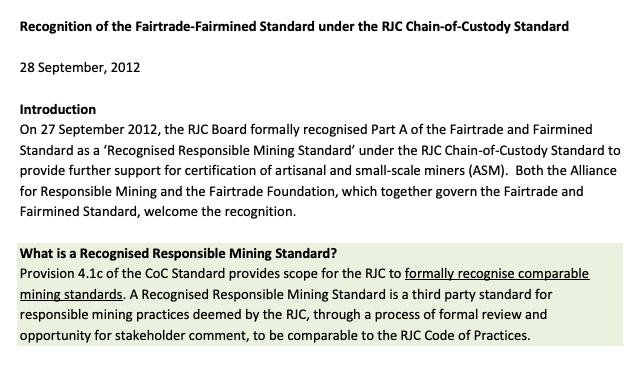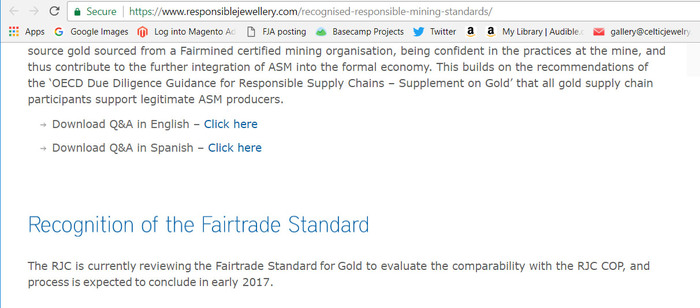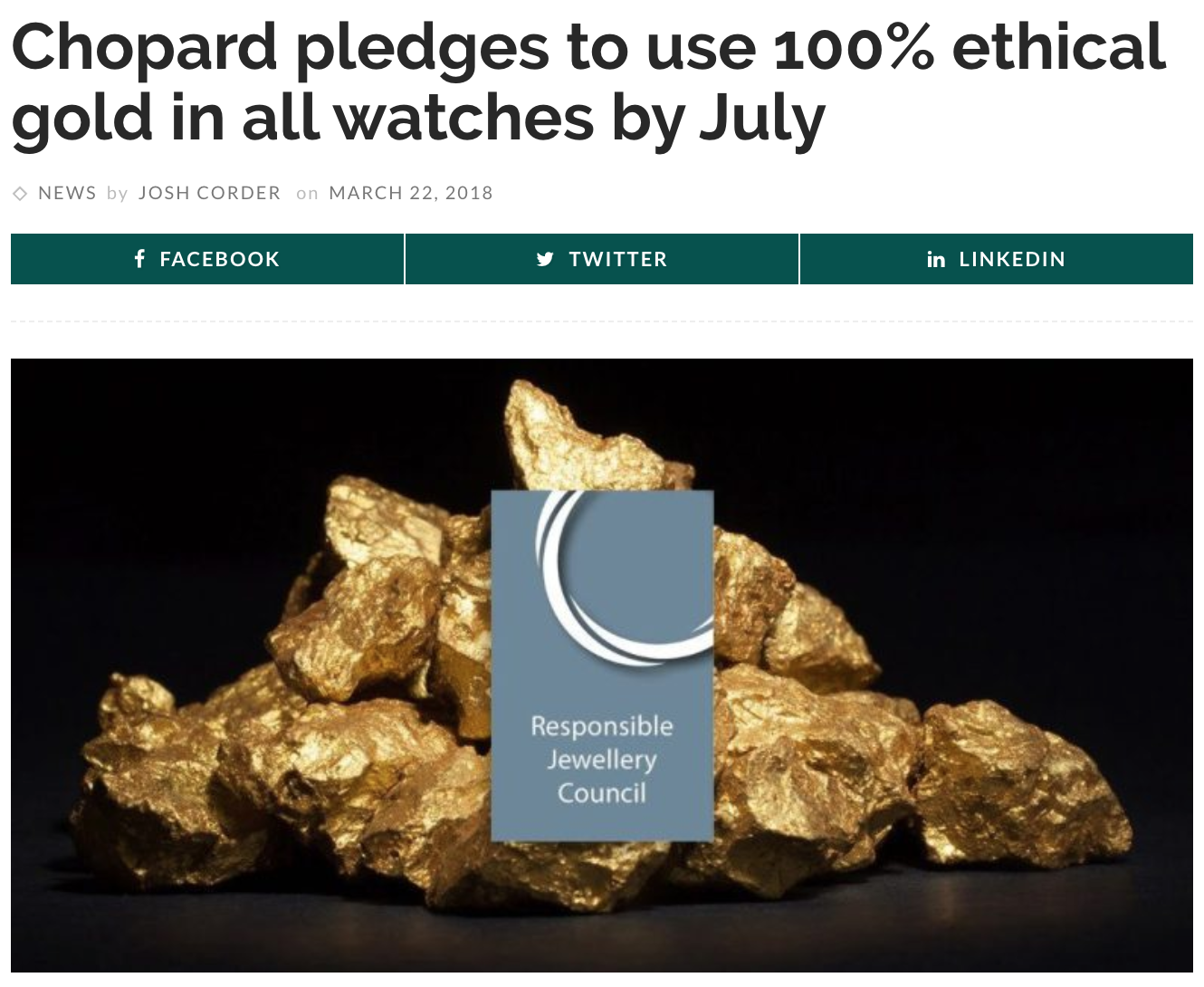NGOs have pointed out for decades that large-scale mining is destructive to the culture and environment of Indigenous people. It has become absolutely critical that large multinationals that have a public profile present strong examples of their concern for small producers.
Inside the Fifth Russian Doll we find the Non-government organizations (NGOs) who work with the Responsible Jewellery Council, and thereby lend it legitimacy.
The Council has signed memorandums of understanding with two prominent NGOs, the Alliance for Responsible Mining (ARM) and The Diamond Development Initiative (DDI). These function as focal points, to demonstrate to the world that the Responsible Jewellery Council cares about the small-scale miner.
The inclusive path, as illustrated by this Council document, as well as the screenshots of the Council ’s homepage referenced earlier, show how large- and small-scale are working together.
These relationships are particularly effective from an ethical jewelry marketing point of view. They allow the mainstream jewelry trade to loudly, boldly declare just how much they are doing, magnifying the impact of these two small programs in a continual flow of positive stories.
These new stories deflect the criticism that the jewelry sector does not support small-scale mining and creates a new forward-facing narrative for the gold from their newly-branded “ethical” large-scale sources.
Let me put it another way, more bluntly:
This is the new "ethical jewelry" strategy of the mainstream jewelry sector’s leaders—benefit a few small-scale miners, scream and shout about it to the world so that you can continue to screw over the rest just as you always have.
[A similar strategy is used by Brilliant Earth, who markets Fairmined/fair trade gold on their site and on Google, without actually offering and Fairmined or "fair trade" gold. Read more here.]
Now, two examples that will illustrate my argument...
The Alliance for Responsible Mining
The Responsible Jewellery Council’s first small-scale mining partnership is with the Alliance for Responsible Mining, which focuses on building capacity among artisanal and small-scale miners. In addition to their formal memorandum of understanding, Felix Hruschka sits on both Responsible Jewellery Council ’s Standards Committee and the Alliance for Responsible Mining board.
These days, the Alliance for Responsible Mining and the Responsible Jewellery Council, as we will explore, are as complementary and coordinated in their messaging as two strands of the same DNA. Yet it is impossible to understand the implications of this partnership without some sense of events leading up to the present.
The Alliance for Responsible Mining started out as a gritty advocate of small-scale miners, working to create standards and principles that could allow ethical gold to reach an international market.
In 2009, the Alliance for Responsible Mining joined Fairtrade International to create a joint standard, as I reported here. Together, they introduced Fairtrade/Fairmined Gold to the UK in 2011.
Fairtrade/Fairmined Gold, for reasons I detail in my supplementary Article Fairtrade/Fairmined in the US/UK, was the single most important breakthrough in the ethical jewelry movement.
For Fairtrade International, it was radical. Up to that point, Fairtrade had only certified agricultural products. But working with the Alliance for Responsible Mining, they were able to branch into the mining sector.
In 2012, the joint Fairtrade/Fairmined standard for small-scale mining was recognized as legitimate. That same year, the Council and Alliance signed a memorandum of understanding.

Screenshot from the Council's Website.
At that junction, activist jewelers, myself included, were optimistic that this move might bring greater clout to the Alliance for Responsible Mining’s efforts to make small-scale mining a prominent issue in the mainstream—yet we were also concerned about how Responsible Jewellery Council’s reputation might hurt the Fairtrade Gold brand.
I outlined these concerns in my post at the time, The Courtship of the Alliance for Responsible Mining and the Responsible Jewellery Council—in which I point out that the Alliance’s alliance with the Responsible Jewellery Council ultimately betrayed the powerful alignment between small-scale miners and pioneer ethical jewelers.
My organization, Fair Jewelry Action, organized this petition to the Alliance for Responsible Mining and Fairtrade against mass balancing, which would have involved mixing gold from responsible small-scale mining with other gold sources. 140 companies signed it.
I felt it was critical for the consumer-facing narrative—in the selling of a wedding ring, for example—that the gold itself be directly traceable to a particular certified mine. In my store, when I have a customer looking for a gold wedding ring, I tell them the story of Macdesa—the present source of our Fairtrade Gold.
If, instead, I had to say a ring was made with gold partially mined at Macdesa, as well as gold from some other, unknown source…it doesn’t have quite the same…ring? Sorry. Quite the same ethical authority.
We were fighting for a new narrative, a new story. Linking a piece of jewelry to a source is a powerful, radical, transformative narrative. Linking the ethics of small-scale mining gold to the ethics of large-scale mining undermined the consumer-facing narrative. Such a move was an extreme threat to a broad ethical-based jewelry movement grounded in small-scale producer-centered benefit.
In 2013, the Alliance for Responsible Mining and Fairtrade split their label. Certainly, one of the causes for this division was the mass balancing issue. Fairtrade began a process of solidifying their international gold program, working with miners and retailers to design a viable commercial platform which would allow the expansion of the market.
Today, Fairtrade Gold and Fairmined Gold are competitors.
Yet, even through 2017, the Council still did not accept Fairtrade’s standards as legitimate—even though, as mentioned above, they recognized the Fairmined/Fairtrade standard in 2012 and since then there has been virtually no significant on-the-ground difference between Fairtrade and Fairmined mining certification.
It needed to review the Fairtrade Standard “to evaluate the comparability with the RJC COP, and process (sic) is expected to conclude in 2017.” (COP = Code of Practice.)

This screenshot was taken on December 31, 2017.
A good joke! Five years for the Responsible Jewellery Council to review whether Fairtrade’s standards are up to their code, which they said were fine in 2012?
There is a strong consensus, particularly among ethical jewelers, that we should not choose sides between Fairmined and Fairtrade. That we should treat them all equally. Yet there has been ZERO outcry from jewelers advocating for the entire small-scale mining sector that the Responsible Jewellery Council has not advocated for Fairtrade Gold.
Imagine if jewelers had demanded that the Council at least endorse the legitimacy of Fairtrade Gold before this year—what a boost it might have been for small-scale miners, as large companies could have joined the Fairtrade scheme.
Yet this did not happen, because Fairtrade is not controlled or beholden to the Responsible Jewellery Council, which is exactly why ethical jewelers should go with the Fairtrade standard over Fairmined.
PS: It was only in January 2018 that Fairtrade Gold was accepted as a legitimate standard by the Responsible Jewellery Council that meets its “code of conduct!”
Chopard’s Fairmined “Responsible” Practices
Yet the most profound influence of the Responsible Jewellery Council/Alliance for Responsible Mining collaboration is that the small-scale story has been blended to add credibility to the Responsible Jewellery Council’s “responsible gold” initiative.
Even more harmful than mass balancing gold is what I would call a kind of “mass balancing the consumer-facing narrative” in relation to small-scale gold mining.
The big recent news on the ethical jewelry front is Chopard’s announcement that all their gold will be “100% ethical.” Chopard is a luxury watch maker.
First, take a look at this screen shot:

Any guesses who might be behind the Chopard initiative? Just to be clear…
Responsible Gold Is Knocking At The Door!
Chopard took five years to launch their initiative. They had a massive inventory of watch casings, bands, etc, that are made of “unethical gold.” These needed to be replaced with the new “responsible gold.”
Chopard’s website (see the screenshot below) explains how Fairmined Gold is used in their product currently.

But let’s look more closely at the Chopard initiative, as explained in this article from Barrons:
“By July, all the gold the company buys will be traceable to small-scale mines that are part of certification systems set up by Alliance for Responsible Mining’s Fairmined, the Swiss Better Gold Association or Fairtrade, or to mines and other suppliers that meet the Responsible Jewellery Council’s “Chain of Custody” standards.” (Italics mine.)
First, notice the structure of the narrative. Fairmined is first. Then second, as a corollary, we’re told of other suppliers that meet the Responsible Jewellery Council’s chain of custody.
Outside of what is used by Fairmined, Chopard’s “responsible” gold comes from Responsible Jewellery Council members. (See the Fourth Russian Doll: Responsible Jewellery Council Chain of Custody Scheme for a full critique of the Council’s chain of custody approach.)
This Vogue article, quoting Caroline Scheufele, explains how they purchase Fairmined Gold “from 5 percent to 10 percent more than the stock market”—yet it won’t affect the price. As a jeweler, I suspect that the 5% might add $25 to $50 to a product’s cost of goods.
An August 24th, 2018 article on Chopard’s initiative, aptly titled “Going Beyond Ethical Gold,” states:
“The move will narrow Chopard's choice to two sources of gold for its jewellery and watches: artisanal freshly mined gold from small-scale mines participating in the Swiss Better Gold Association, Fairmined and Fairtrade schemes; and RJC Chain of Custody gold, through Chopard's partnership with RJC-certified refineries.”
A luxury brand is essentially anchoring the consumer narrative that small-scale gold is equally ethical to Council’s supply chain, and this initiative is reinforced by journalist and bloggers.
For example, this article in Vogue lauding Chopard states, “The RJC certification doesn’t guarantee traceability, but the latest version – released at the end of 2018 – will do its due diligence by outlining the steps certified members have to take to avoid exacerbating conflict and violating human rights.”
Chopard’s Co-president Karl Scheufele speaks of the initiative in emotional terms. We are told that it is a family business…sustainability has always been a core value…ethical gold is the culmination of a 30 year vision. “It is a bold commitment, but one that we must pursue if we are to make a difference to the lives of people who make our business possible.”
He is also endorsing the Grandfather policy referenced earlier, in which reiteration of colonial business practices are granted impunity—an impunity which hides alleged crimes that can be clearly viewed.
There is no question that Chopard’s high-profile initiative helps some small-scale mining communities. It may be that Chopard does not fully understand the weaknesses of the Responsible Jewellery Council’s certification. Their endorsement of the new “responsible gold” could be a reputation risk if the public understood what’s taking place.
Yet for now, the Responsible Jewellery Council will squeeze every possible ounce of publicity out of the tiny amount of gold certified by the Alliance for Responsible Mining—a minute fraction of the total produced by Council members. This gold, which effects no real change for the vast majority of small-scale miners, is the new face of “responsible gold.”
“Responsible gold” essentially creates a new narrative of Fairmined Gold from small-scale miners and the large-scale multinationals. Because the Responsible Jewellery Council's “responsible gold” brand is anchored by Chopard’s narrative, Fairmined Gold = Responsible Jewellery Council’s new “responsible gold.”
Continue on to the Fith Russian Doll Part B: Death of the Fair Trade Diamond
Return to the Fourth Russian Doll: Responsible Jewellery Council Chain of Custody Scheme
Return to the Landing Page

**All writing and images are open source, under Creative Commons 3.0. Any reproduction of this material must back link to the landing page, here. For high resolution images for publication, contact us at expose(AT)reflectivejewelry.com.**